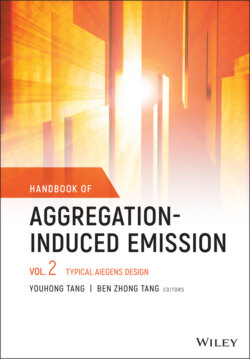Читать книгу Handbook of Aggregation-Induced Emission, Volume 2 - Группа авторов - Страница 31
2.2.1.5 Multistimuli‐responsive Materials
ОглавлениеMultistimuli response refers to the phenomenon that the fluorescence properties of molecules change reversibly under the action of various external stimuli (such as pressure, heat, light, solvent).
The fluorescence of DSA derivative powders 1‐2 changed from green to red after being fumed with HCl, and the fluorescence color could be returned to the initial state after being fumed with triethylamine [27]. Meanwhile, the fluorescence of the initial powders changed to red under pressure, and the fluorescence could also return to the initial state after heating. Compared with DSA derivative 1‐2, DSA derivative 1‐14 has two more benzene ring substituents, and it also has multistimuli response properties. The two polymorphs (G‐phase and O‐phase) based on compound 1‐14 were obtained by using a solvent evaporation method. They exhibit remarkable luminescence switching under the multistimuli such as grinding force, hydrostatic pressure, and acid and alkali treatments. The G‐phase with J‐type aggregation shows a green emission, while the O‐phase with H‐type aggregation presents an orange emission. The aggregation states of the two polymorphs changed under the grinding, resulting in red‐shifts of luminescence. Upon further heating the ground samples, both of them partly recovered their initial emissive colors. Furthermore, a structural transition from the O‐phase to G‐phase took place during grinding and subsequent heating processes. The O‐phase showed a more obvious red‐shift than the G‐phase. The molecular geometry of the O‐phase tended toward a more planar conformation than that of the G‐phase under the same hydrostatic pressure. It showed that the O‐phase has a higher sensitivity to the hydrostatic pressure than the G‐phase, which resulted from the different intermolecular interactions inside the two crystalline phases. The protonation–deprotonation of the two polymorphs showed that fumigation with HCl/diethylamine (DEA) vapor leads to the destruction and reconstruction of the noncovalent C–H⋯N bonds, resulting in more distinct luminescence switching in the G‐phase than in the O‐phase [48].
Two DSA derivatives, 1‐15 and 1‐16, have been synthesized and investigated. Both of them have AEE properties. 1‐15 with heteroatom N exhibits remarkable solvatochromism, reversible chromism properties, and self‐assembly effects. When increasing the solvent polarities, the green solution of 1‐15 turns orange with the fluorescence emission wavelength red‐shifting from 527 to 565 nm. Notably, 1‐15 shows reversible mechanochromism and thermochromism properties. The as‐prepared powders of 1‐15 emit a green fluorescence (λ = 525 nm) and the color can change to orange (λ = 573 nm) after grinding; further, the orange color can return to green color at high temperature. Based on these reversible chromism properties of 1‐15, a simple and convenient erasable board was designed. However, different from 1‐15, 1‐16 without heteroatom N has no obvious chromic processes. The investigation results obtained from X‐ray diffraction, differential scanning calorimetry, single‐crystal analysis, and theoretical calculations confirmed that the chromic processes depend on the heteroatoms N in 1‐15 [49].
DSA derivative 1‐17 containing alkyl chains of different lengths also has different degrees of response to various external stimuli [31]. When n ≥ 10, these compounds showed obvious piezofluorochromic properties. The crystal structure analysis found that supramolecular interactions have a great influence on its piezofluorochromic properties. At the same time, these compounds responded significantly to solvent vapor and temperature.
